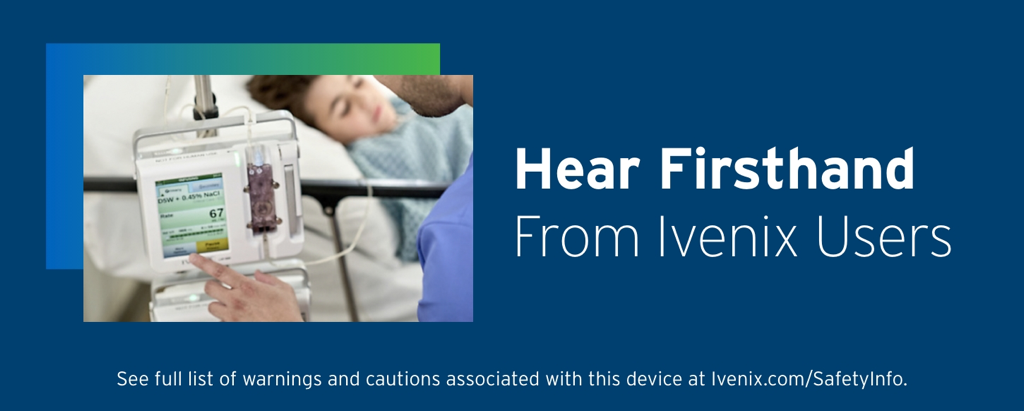
Since 1927, San Luis Valley Health has been growing, innovating, and providing high-quality health services to the community. With the implementation of the Ivenix Infusion System, it has taken a significant step toward its commitment to delivering state-of-the-art care.
Positioning Itself at the Forefront of Healthcare
The rapid evolution of healthcare technology continuously presents new opportunities that can help improve outcomes and operational efficiency. By adopting the Ivenix Infusion System, San Luis Valley Health is not only addressing their current needs but also positioning itself at the forefront of future healthcare advancements. The Ivenix Infusion System features a smartphone-like touchscreen, optional EMR integration, real-time dose guidance supported by an up-to-date drug library, and software designed to support ongoing updates.1
“The feedback from the staff has been fantastic,” says Roberta Bean, MSN, RN, NEA-BC, Chief Nursing Officer at San Luis Valley Health. Watch the video for more from the staff at San Luis Valley Health on the Ivenix Infusion System.
Bringing Innovation to the Forgotten Frontier
Importantly, this implementation spans two of San Luis Valley Health’s smaller rural hospitals. Rural hospitals are crucial to their communities, often serving as the primary source of healthcare for geographically isolated populations. Despite being smaller and generating less revenue, rural hospitals play a vital role in providing care and supporting local economies. They account for about 35% of all hospitals in the US and contribute significantly to rural employment and economic activity.2
Becoming known as the “forgotten frontier,” rural hospitals face unique challenges, including financial vulnerabilities and limited resources. Many rural residents must travel long distances to access care, particularly when local hospitals close, exacerbating healthcare disparities.3,4 By equipping its facilities with technology like the Ivenix Infusion System, San Luis Valley Health is supporting its commitment to patient care in its community-focused hospitals.
The Ivenix Infusion System Is Engineered for Efficiency
Due to financial vulnerability, rural hospitals not only seek the latest technology to help support patient care, but they often seek technology designed for efficiency. This is just another area in which Ivenix is designed to deliver.
Infuse to Empty:
Secondary infusion automation promotes delivery of the entire bag and detects when the secondary line is clamped.1
No Scheduled Preventive Maintenance*:
Pneumatic pumping technology self-calibrates for every infusion. If inspected for physical damage during cleaning, there is no scheduled reason to collect the pumps for a technical touch.1
Wirelessly Updates in Minutes:
Automated drug library and software updates take 4 minutes or less to minimize downtime and interruptions to care.1
"My hands-down favorite part of the Ivenix pump is the ‘infuse to empty’ feature. I used to spend so much time going to check for overfill."
- Samantha Crawford, Nurse at San Luis Valley Health
Because San Luis Valley Health is a nonprofit organization, it needed to spend its precious donated funds wisely. With a large screen that’s viewable from across the room, unique pumping technology that infuses accurately and consistently under typical clinical conditions,† and the option for interoperability built in, they’ve realized a simply efficient experience with the Ivenix Infusion System.
*Refer to the IFU for recommended maintenance of the LVP.
†Overall accuracy +/- 5% under the following conditions: 0.5-1000 mL/hr; 5°C to 35°C ambient temperature; 10 PSIA-15.5 PSIA ambient pressure; -100 mmHg to 525 mmHg backpressure; +/- 24” inlet
Please see full list of warnings and cautions associated with this device
*First and only in US market as of 8/24.
†Overall accuracy +/- 5% under the following conditions: 0.5-1000 mL/hr; 5°C to 35°C ambient temperature; 10 PSIA-15.5 ambient pressure; -100 mmHg backpressure; +/- 24” inlet head height; viscosities up to 70% dextrose solution; up to 96-hour duration; microbore and macrobore sets.
- “Sepsis Awareness Month.” Sepsis Alliance, 21 Jan. 2019, https://www.sepsis.org/get-involved/sepsis-awareness-month/.
- Jackson, Karen E., and Matthew W. Semler. “Advances in Sepsis Care.” Clinics in Chest Medicine, vol. 43, no. 3, Elsevier BV, Sept. 2022, pp. 489–498.
- Sepsis Alliance. Sepsis Fact Sheet. 2023. https://www.sepsis.org/education/resources/fact-sheets/
- Chua, Wei Ling, et al. “Nurses’ Knowledge and Confidence in Recognizing and Managing Patients with Sepsis: A Multi‐site Cross‐sectional Study.” Journal of Advanced Nursing, vol. 79, no. 2, Wiley, Feb. 2023, pp. 616–629.
- American Nurse Journal. “Antibiotic Stewardship for Staff Nurses.” American Nurse, 11 May 2016, https://www.myamericannurse.com/antibiotic-stewardship-staff-nurses/.
- Glynda Rees Doyle and Jodie Anita McCutcheon. “7.6 Administering Intermittent Intravenous Medication (Secondary Medication) and Continuous IV Infusions.” Clinical Procedures for Safer Patient Care.
- Giuliano, Karen K., et al. “Secondary Medication Administration and IV Smart Pump Setup.” The American Journal of Nursing, vol. 121, no. 8, Ovid Technologies (Wolters Kluwer Health), Aug. 2021, pp. 46–50.
- Ivenix Infusion System Large Volume Pump (LVP) Instructions for Use. Bad Homburg, Germany: Fresenius Kabi, 2024.
- Open Resources for Nursing (Open RN), et al. Chapter 23 IV Therapy Management. Chippewa Valley Technical College, 2021.


